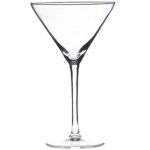

Fun Facts About Cocktail Glasses
Cocktails are a pleasure in themselves, but there is also plenty of fun to be had from the history and stories behind the glasses they are traditionally served in, as the following facts should show.
The Martini Glass Story
The Martini glass's slim stem was designed to prevent the drinker's hand from touching the drink-filled bowl, as the warmth could destroy the flavour.
The Martini glass's open top is supposed to create surface tension to convey the gin's bouquet and ensure an elegant exhibition of the traditional olive garnish.
The cone shape of the Martini glass is supposed to stop the ingredients from separating, but many people think that the glass was first invented during Prohibition and the wide opening made it easier to dispose of banned alcohol if the police arrived.
Sales of these Martini glasses sky-rocketed thanks to their starring role in James Bond films and 007's 'shaken not stirred' preference.
Fans of the classic Martini glass are said to include F. Scott Fitzgerald, Winston Churchill, Alfred Hitchcock, Franklin Delano Roosevelt and Frank Sinatra.
Serving Suggestions
Jam-jar cocktails are all the rage, and the hippest mixologists are constantly searching for innovative cocktail glasses and serving suggestions. These include everything from wellington-boot-shaped glasses to skulls and even goldfish bowls.
One of the earliest well-known Tiki bars, Don the Beachcomber, was opened in 1933 in Los Angeles. Since then, their popularity has increased around the world and so has the popularity of drinking cocktails out of extravagant Tiki glasses at home.
Highball glasses are popular for serving 'long' cocktails, but it is thought they were originally used to serve Scotch and carbonated water to railroad workers in the late 1800s. It is believed the name came from coloured balls placed near stations to tell train drivers that they could go full steam ahead.
Hurricane glasses were inspired by hurricane lamps, which were used to serve bright red hurricane cocktails in New Orleans' Pat O'Brien's bar in the 1940s.
Some people believe that the first Margarita glasses were inspired by champagne coupes and were made using recycled Coca Cola bottles.
The name of the Julep Cup comes from the Persian word gulab and the Arabic world julab, which means rosewater. The origins of today's cups date back to the start of the 19th century, when they were created by Kentucky silversmiths.
The idea of the snifter glass can be traced back to Ancient Egypt, when they were made of gold and used to hold brandy for drinking for ritual purposes.
Drinks parties aren't always cocktail glass-filled affairs, however. Punch cups were the order of the day during William III's reign, when Edward Russel, the English forces' captain general, threw an incredibly extravagant party. The garden fountain became a huge punch bowl filled with 560 gallons of brandy, 1,300lbs of sugar, 5lbs of nutmeg and 20 gallons of lime juice. A small boat was filled with punch glasses, and a bartender rowed around to visit guests and fill up their cups.


Validate your login
Login
Create New Account